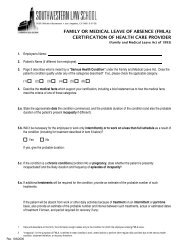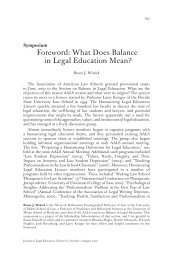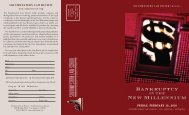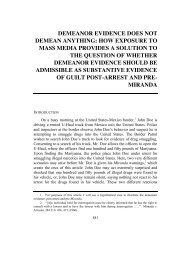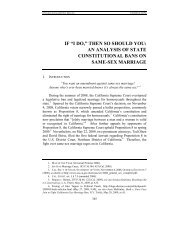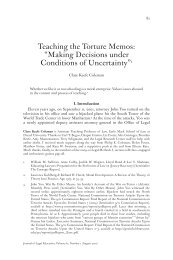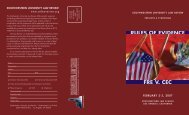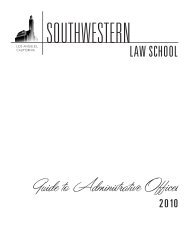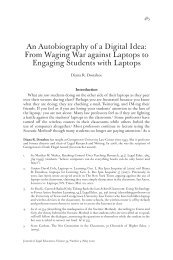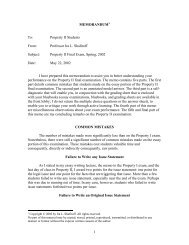What is Art? - Southwestern Law School
What is Art? - Southwestern Law School
What is Art? - Southwestern Law School
- No tags were found...
Create successful ePaper yourself
Turn your PDF publications into a flip-book with our unique Google optimized e-Paper software.
WHAT IS ART? 119property rights laws, the Senate exerc<strong>is</strong>ed its inherent jur<strong>is</strong>dictionalpowers over trade to allow Raimondi to continue producing and merchand<strong>is</strong>ingDürer’s images; with the prov<strong>is</strong>o that he could not in thefuture include on them Dürer’s unique ‘AD’ signature or brand. 29Not only <strong>is</strong> th<strong>is</strong> one of the earliest recorded cases in the developmentof copyright laws, it also illustrates the Senate’s difficulty in understandingthe true nature of Dürer’s art (and h<strong>is</strong> legal claim). TheSenate seemingly focused on the innovative and highly technicalskill and labour Raimondi employed in making engraved copies; noton the art. Dürer’s original images were the art; not h<strong>is</strong> original woodcutsor h<strong>is</strong> prints thereof, and not Raimondi’s engraved renditions ofDürer’s original images or h<strong>is</strong> prints thereof. In granting Dürer a remedyin relation to Raimondi’s future use of h<strong>is</strong> “logo”—h<strong>is</strong> brandidentity—the Senate also heralded the development of what becametrademark and other intellectual property laws.1573 Italy: Inquiry of the Venetian Inqu<strong>is</strong>ition v. Veronese 30In 1572, at the height of h<strong>is</strong> career, Veronese 31 was comm<strong>is</strong>sionedby the monastery of San Giovanni e Paolo in Venice to make a largepainting of The Last Supper to adorn the refectory, to replace an earlierwork by Titian 32 that had been destroyed by fire the previousyear. In 1573 Veronese delivered a very large canvas, 39 feet wideby 17 feet high, on which he had updated the ancient Biblicalscene by placing it in a contemporary Italian palazzo. 33 He had expandedthe traditional gathering of Jesus and h<strong>is</strong> twelve d<strong>is</strong>ciplesby adding a large number of curious-looking people, including “buffoons,drunken Germans, dwarfs and other such scurrilities ...ajesterwith a parrot on h<strong>is</strong> wr<strong>is</strong>t . . . a servant who has a nose-bleed from someaccident...armedmendressedinthefashionofGermany,withhalberdsin their hands” 3429.30. For an Engl<strong>is</strong>h translation of the trial transcript, See FRANCIS MARION CRAWFORD,SALVE VENETIA: GLEANINGS FROM VENETIAN HISTORY. VOLUME: 1 (1905); Elizabeth C.Childs, Suspended License: Censorship and the V<strong>is</strong>ual <strong>Art</strong>s (1997).31. Paolo Cagliari (1528–1588), popularly known as Veronese from the city of h<strong>is</strong>birth, Verona was an eminent fresco and oil painter in the Manner<strong>is</strong>t style of the ItalianLate or High Rena<strong>is</strong>sance, especially in Venice alongside Titian and Tintoretto.32. Tiziano Vecellio (1488–1576), popularly known as Titian, was the pre-eminentmember of the so-called Venetian <strong>School</strong>, with Veronese and Tintoretto.33. Such “modern<strong>is</strong>ation” was commonly pract<strong>is</strong>ed by art<strong>is</strong>ts during theRena<strong>is</strong>sance.34. Crawford, supra note 30; Childs, supra note 30.



